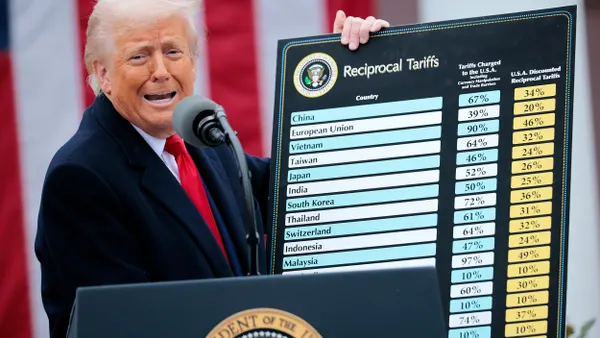UPDATE: March 11, 2024: Amazon defended its DSP and said the platform makes it easier for advertisers to access third-party exchanges serving ads on the open web, per a statement shared by a company spokesperson following this story’s publication.
“We maintain a high bar on the supply that is available for our advertisers and proactively block made-for-advertising inventory available through a combination of manual and automated processes,” the statement said. “We also enable advertisers to decide where their ads appear through a mix of proprietary and third-party controls.”
Dive Brief:
- Ads from top brand marketers like Procter & Gamble, Hershey and Mondelez International continue to appear on click-bait Made for Advertising (MFA) websites despite recent pledges by ad-tech and media firms to crack down on the problem, according to a new report from Adalytics.
- Leading supply- and demand-side platforms (SSPs and DSPs), including offerings from Google, Amazon and Microsoft, along with a number of retail media networks transact on MFA inventory, Adalytics alleges. Media agencies from all seven of the major ad-holding companies were also implicated in the practice.
- MFAs have been in the spotlight following a study from the Association of National Advertisers (ANA) from June that revealed a massive amount of wasted programmatic ad spend. Brands are concerned that MFAs hurt credibility and consumer trust while leading to worse business outcomes.
Dive Insight:
In the wake of the ANA’s programmatic transparency report last summer, there was a deluge of pledges to get tough on MFAs from all stripes of ad-tech vendors and media agencies. Just a few months after MFAs became a hot topic, programmatic stakeholders appeared confident they were on the right track toward a solution. Adalytics’ latest research indicates that many of those proclamations may have been lip service as brand marketers are still seeing their dollars wasted on websites with sensationalist headlines, questionable content and janky designs.
The scope of companies allegedly continuing to transact around MFAs is wide-ranging. DSPs named in the lengthy report include Google Display & Video 360, Amazon DSP, Roku OneView and AdTheorent, while Google Ad Manager, Criteo, Microsoft Xandr, Magnite and Pubmatic were among the ad exchanges and SSPs.
Vendors can filter out MFAs or provide other guardrails unless the buyer explicitly chooses to opt in to running ads on those types of websites. AdTheorent, for example, has a partnership with Jounce Media to remove MFAs from campaigns unless the advertiser demands otherwise.
Agencies from all of the major ad-holding groups, including the big four of Omnicom, Publicis, Interpublic Group and WPP, were represented. Adalytics fingered retail media networks as a major culprit, calling out Amazon’s platform, specifically, as an offender. Amazon’s advertising operations have faced scrutiny recently following a portion of an antitrust complaint against the e-commerce giant that alleged executives welcomed “defect” ads to run on its platform.
Marketing Dive has reached out to Amazon and Google for comment on the Adalytics report and will update this story pending a response.
The Trade Desk and Walmart DSP, which the retailer built on top of The Trade Desk’s tech, were not seen transacting on MFAs, a factor Adalytics attributed to the DSP’s tighter inventory policies. Kargo, TrustX and Ozone Project were some of the other companies that were clear of MFA offenses.
An industry has burgeoned around intermediaries that work to ensure digital ads only appear on high-quality, brand-safe websites. But Adalytics noted that many ads running on MFAs carry measurement and verification tags from vendors like Integral Ad Science, DoubleVerify, Oracle Moat and Pixalate.
With generic domain names like daily-stuff.com and followsports.com, MFAs use shady tactics to mask their purpose, hiding from search engines or showing a different web experience when visited directly to read as more legitimate. Paid traffic and recommendation platforms like Outbrain and Taboola help prop up pages that otherwise see virtually no organic reader interest.
MFAs rely on junk content and are built to be blanketed with display and video ads, rapidly refreshing placements to maximize exposure. Because MFAs do not employ the usual ad frequency capping safeguards, brands that appear on them can pay “astronomically high prices to reach a single consumer,” according to Adalytics. The researcher pointed to a Kroger campaign that saw the grocer pay an effective CPM of $5,491 to reach one person via an MFA.
Adalytics used several methods to track which brands, government entities and nonprofits were still seeing campaigns run on MFAs in 2024. Sixteen of the 17 marketers that were disclosed as participating in the ANA’s first look report, including Molson Coors, Dell and State Farm, had ad impressions served on websites that could be classified as MFAs based on definitions shared by trade organizations and watchdog groups. Furthermore, 80% of SSPs invited to participate in a showcase for suppliers hosted by the ANA earlier in March were confirmed to be serving ads for member marketers of the trade body on MFA sites.
The Adalytics study is peppered with statements and media interviews with firms that claim to be doing more to tamp down on MFAs, drawing contrast with their behavior. For instance, Pubmatic was found by Adalytics to have transacted ads for over 7,500 brands on the sample of MFA sites analyzed this year. Meanwhile, a blog post published by Pubmatic in June, titled “Advancing Responsible Media By Removing MFA Inventory From Auction Packages,” was previously deleted or made inaccessible.
Clarification: This story has been updated to offer more specifics regarding how ad-tech firms might handle transacting on Made For Advertising websites. While some vendors continue to transact on MFAs, they only do so because the advertiser explicitly opts in to the practice.













